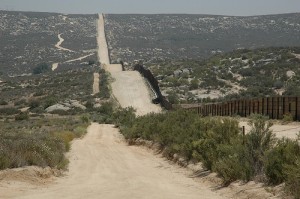Editor’s Note – This topic is apparently so beaten to death that no one in the Department of Homeland Security or at the Justice Department wants to talk about it from this point forward and that includes the money allocated from Appropriations. If there are any non-believers out there that think Washington DC does not care about the Southern Border and the associated corruption and failed national security interests, then just spend one full day on the border, but bring along your own security.
Technology, humanitarian aid, and financial military support goes to Afghanistan and Pakistan in the billions of dollars but this White House has decided to trim the border security at our Southern border by half when it comes to assets and construction of the fence. Sure, it does not need to be a physical fence, but understand there are hundreds of miles exposed with no line of demarcation. The bottom line is, any borders with no protection of any sort is a failure of national security.
Please read the two articles below:
Obama Has Halved Spending on Border Fencing, Infrastructure, Technology–Leaving 1,300 Miles of Mexico Border Unfenced
By Edwin Mora
(CNSNews.com) – The Obama administration has slashed spending on border fencing, infrastructure and technology, cutting it by more than half since it peaked under President George W. Bush in fiscal 2008, according to a Government Accountability Office report.
In 2008, according to GAO, the federal government spent more than $1.3 billion on border security fencing, infrastructure and technology. In 2011, it spend $573 million.
Meanwhile, Customs and Border Protection has said that as of June it had fenced only 649 miles of the nearly 1,954-mile-long U.S.-Mexico border–leaving more than 1,300 miles of that border unfenced.
The November 2011 GAO report refers to this category of federal spending by the acronym BSFIT.
“Over $4.7 billion has been appropriated for BSFIT activities from fiscal years 2007 through 2011,” it says.
The report breaks the figure down for the five consecutive fiscal years (the 12-month period from Oct. 1 to Sept. 30 of the following year) – $1.188 billion for FY2007, $1.303 billion for FY2008, $845 million for FY2009, $800 million for FY2010 and $573 million for FY2011.
Over that period, the annual appropriations for border security therefore peaked in FY2008 under President Bush and declined to its lowest level in FY2011 under President Obama.
“An across-the-board cut to DHS appropriations of 0.2 percent reduced the BSFIT appropriation to $573 million [in fiscal 2011],” notes the GAO. The report added that some of the annual appropriations covered in the report do not expire at the end of the fiscal year for which they were allotted.
The report also stated that last January, “after 5 years and a cost of nearly $1 billion,” the DHS ended the Secure Border Initiative Network (SBInet) – also known as the virtual fence – “because it did not meet cost-effectiveness and viability standards.”
“DHS is developing a successor plan to secure the Southwest border called the Alternative (Southwest) Border Technology plan,” the report adds. “The plan’s first phase is the Arizona Border Surveillance Technology Plan, which also includes a mix of radars, sensors, and cameras.” It is expected to cost about $1.5 billion over 10 years.
Explaining how the appropriations have been directed, the report said that in November 2005 the DHS initiated the Secure Border Initiative (SBI), described as “a multiyear, multibillion-dollar effort aimed at securing U.S. borders and reducing illegal immigration.”
Under the SBI, the DHS’s U.S. Customs and Border Protection (CBP) implemented the following programs:
- SBI Network (SBI): radars, sensors, and cameras along 53 miles of Arizona’s 376-mile border with Mexico;
- Northern Border Program: cameras, radars, and operations centers along the border with Canada;
- Tactical Communications Modernization: an upgrade to the CBP communications systems; and
- Tactical Infrastructure – fences, roads, and lighting along the southwest border.
According to the CBP, as of the end of June 2011 it had completed 649 miles of pedestrian and vehicle fencing along the approximately 2,000 mile-long Southwest border.
“A total of 350 miles of primary pedestrian fence has been constructed, while the final total of vehicle fence (the project was officially completed on January 8, 2010) was 299 miles,” it says.
A “primary pedestrian fence” is aimed at preventing the illegal passage of people while a “vehicle fence” is focused on stopping the unauthorized passage of vehicles.
“Their placement depends on the threat at the location and the operational needs of law enforcement,” CBP says.
CBP is responsible for securing a total of 8,607 miles of the U.S. border, including about 2,000 miles of the U.S.-Mexico border, approximately 4,000 miles of the U.S.-Canada border, plus sectors of coastline in the Gulf of Mexico, Puerto Rico, and the U.S. Virgin Islands.
As of the end of fiscal 2010, the U.S. government had established “effective control” over 1,107 miles of the 8,607 miles it is responsible for securing – 69 miles along the northern border, 873 on the U.S.-Mexico border and 165 miles in coastal sectors.
Less than half of the southwest border and less than two percent of the northern border are therefore under “effective control.” The term applies to those areas where the U.S. government can be “reasonably” be expected to intercept illegal cross-border activity
The Holes Found in U.S. Border Fence Technology
After 20 years and billions of dollars, securing the southern border remains a seemingly insurmountable challenge. Why is it so hard to build a fence that works?
By Dan Koeppel
As lines in the sand go, this steel structure is designed to be the toughest on earth to cross. The 15-foot-high fence extends west of Nogales into the Arizona desert, undulating and curving as it follows the border with Mexico. South of the fence, hillside houses rise beyond a hundred-yard-wide no man’s land. Some houses contain migrant laborers who will try—perhaps even tonight—to cross this line. A pickup truck makes its way up a gravel cut that zigzags across a hillside on the Mexican side. “He’s watching us,” says Border Patrol agent Mario Escalante. “He’s trying to gather intelligence—and so are we.”
This kind of fence—one of about a dozen different barrier types found along the southern border—has a name that sounds like something the Army would give its brawniest tank: the anti-ram. From a distance, it looks like an array of dark-colored vertical blinds.
On closer inspection, the slats reveal themselves to be steel pipes 4 inches in diameter filled with concrete poured around interior skeletons of rebar. The fence is modular, built in segmented panels 8 feet wide and sunk 6 feet into the ground.
One manufacturer claims it would take two men, each with a power saw, nearly 40 minutes to cut a 2-foot-wide hole in its anti-ram fencing, and they’d need to carry additional fuel and extra blades to do it. And if the fence’s name invokes images of an impenetrable barrier to powerful machines, it should—some anti-ram fences are designed to withstand a 40-mph impact by a 10,000-pound vehicle. Such defensive measures don’t come cheap: The average cost of vehicle fencing is $1 million per mile.
For more than 20 years, politicians from both parties have held the same basic position on the nation’s frontiers. “First, the United States must secure its borders,” President George W. Bush said on May 15, 2006. “This is a basic responsibility of a sovereign nation.” President Obama noted on April 29, 2010: “It is the federal government’s responsibility to enforce the law and secure our borders. . . .”
Few political leaders have disagreed with these sweeping sentiments. And polls show that about 60 percent of Americans are in favor of a barrier that they believe will curb illegal immigration, drug smuggling and terrorists.
Since 1990, the U.S. has barricaded about 650 miles of the nearly 2000-mile border with everything from rudimentary barbed wire to fencing made of Army surplus helicopter landing mats to three-sided steel barriers that look like bulked-up versions of the tritons that littered the World War II beaches of Normandy. More recent designs include concrete and steel bollards—vehicle-stopping posts similar to the kind found at entrances to government buildings, office towers and shopping malls. Some of the most expensive barriers—remotely operated surveillance systems—have been deployed in several field tests but with disappointing results.
Despite all the time, effort and money spent on both physical and virtual fences, about 175,000 migrants, mostly coming for work, made it past existing barriers in 2008. After decades of effort, bipartisan consensus and billions of dollars, America’s southern border seems as permeable as ever. And the frustrated American public wants to know: What’s so hard about building a fence?
At the headquarters of the Border Patrol’s Tucson sector, in a room filled with video monitors, agents play for me a recording made two weeks ago, in early January. The incident began with a hit from a motion sensor buried 50 miles south in the Sonoran Desert.
Read the rest here: Popular Mechanics


